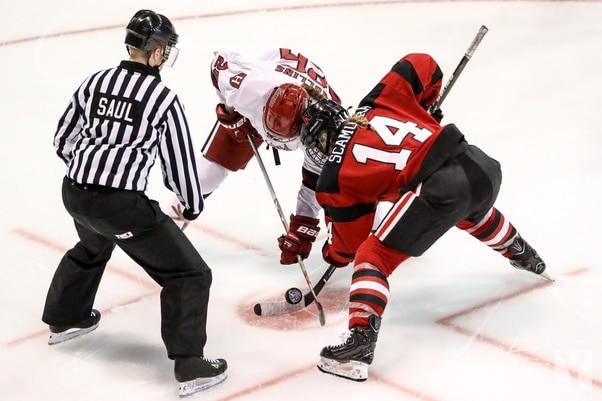Hockey is known for its intensity, skill, and strategic gameplay. To fully appreciate and enjoy the game, it’s crucial to understand its structure, including the concept of quarters. While quarters are more commonly associated with sports like basketball and American football, hockey has its own unique way of dividing the game.
In this article, we’ll delve into the world of hockey, exploring the quarters, their significance, and how they contribute to the overall flow of the game.
Table of contents
How Many Quarters Are in a Hockey Game?
Contrary to popular belief, hockey games are not divided into quarters but into periods. They typically play a standard hockey game over three periods, each lasting 20 minutes. Intermissions separate these periods, allowing players to rest, strategize, and regroup.
While the clock runs continuously during each period, it stops for various reasons, such as stoppages in play, penalties, and goals. This ensures that each period is approximately 20 minutes of playing time.
However, the total duration of a hockey game can vary because of these stoppages, making the actual time elapsed longer than the sum of the three periods. It’s worth noting that while the standard format involves three periods, youth or amateur hockey leagues might choose to modify the structure for various reasons, sometimes opting for quarters instead.
Related Article: How Many Super Bowls Has Aaron Rodgers Won: Celebrating the Triumphs of a Football Legend
How Long is Each Period in Hockey?
In a standard professional ice hockey game, each period lasts for 20 minutes of actual playing time. However, it’s important to note that the total duration of a period can be longer due to stoppages in play, penalties, and other interruptions.
The clock stops for various reasons during a game, such as when a goal is scored, when the puck goes out of play, or when penalties are assessed. Intermissions between periods provide players with a break, and the ice may be resurfaced during these breaks to maintain optimal playing conditions.
Is There a 4th Period in Hockey?
In standard professional ice hockey, there is no official fourth period. A hockey game is traditionally divided into three periods, each lasting 20 minutes of playing time. After the first and second periods, there is an intermission during which players get a break, and teams can regroup and strategize.
However, if a game is tied at the end of the third period in the regular season, the NHL introduces an overtime period. During the regular season, the overtime period is sudden death, meaning the first team to score wins the game.
If no goals are scored during the overtime period, the game may proceed to a shootout, where each team has a chance to take penalty shots.
In playoff games, the format is different. Overtime periods continue until a goal is scored, and there is no shootout during the playoffs.
Read This: How to Frame a Puzzle: Artistic Display Technique
Why Does Hockey Have 3 Periods instead of 4 Quarters?
The decision to have three periods instead of four quarters in hockey is largely rooted in tradition and practicality. The game of hockey has evolved over time, and a combination of historical practices has shaped its structure and the nature of the sport itself.
Here are some reasons hockey adopted three periods:
Historical Development
The game of hockey has a long history, dating back to the 19th century. When the structure of the game was formalized, the decision to divide it into three periods was likely influenced by other team sports that were already established with a similar three-part structure.
Natural Breaks
The fast-paced nature of hockey makes it challenging to incorporate frequent breaks without disrupting the flow of the game. The intermissions between periods provide a natural break for players to rest, coaches to strategize, and for the resurfacing of the ice, ensuring optimal playing conditions.
Television Broadcasting
The three-period structure also aligns well with television broadcasting schedules. Intermissions between periods allow for commercial breaks, contributing to the financial aspects of the sport. This has become a significant consideration in the modern era of sports.
Player Fatigue
Hockey is an intense and physically demanding sport. Dividing the game into three periods allows players to have regular breaks, reducing fatigue and promoting player safety. This structure ensures that players have sufficient rest to maintain a high level of performance throughout the game.
While the three-period structure is the standard in professional ice hockey, variations exist at different levels of the sport.
See this: How to Draw Heads: Artistic Skill Development
Is Hockey the Only Sport with 3 Periods?
No, hockey is not the only sport with three periods. While three periods are a distinctive feature of ice hockey, there are other sports that also use a similar structure, though the terminology may vary.
Here are few of them:
- Field Hockey: Like ice hockey, field hockey also features three periods. Each period is typically 15 minutes long, and there are breaks between the periods.
- Roller Hockey: Roller hockey, played on inline or roller skates, often follows a structure similar to ice hockey, with three periods.
- Ringette: Ringette, a sport similar to ice hockey but played with a straight stick and a rubber ring, typically consists three periods.
- Box Lacrosse: Box lacrosse, a variant of lacrosse played indoors, is divided into three periods, each lasting a specific amount of time.
FAQs
In regular-season NHL games, if the score is tied at the end of the third period, an overtime period is played, and if necessary, a shootout may follow. In playoff games, overtime periods continue until a goal is scored.
In professional ice hockey, there are no quarters; the game is divided into three periods.
The three-period structure in hockey is rooted in tradition, historical development, and practical considerations, such as player fatigue, natural breaks, and television broadcasting schedules.
Each period in a professional hockey game typically lasts 20 minutes of actual playing time. However, the total duration can be longer due to stoppages, penalties, and other interruptions.
Conclusion
While hockey games are officially divided into three periods, the concept of quarters is not entirely foreign to the sport. Understanding the structure of a hockey game, including its periods and potential overtime scenarios, is essential for both new and seasoned fans.
Whether you’re watching a professional game or cheering on a youth team, grasping the dynamics of the game’s structure enhances the overall viewing experience and appreciation for the sport of hockey.






